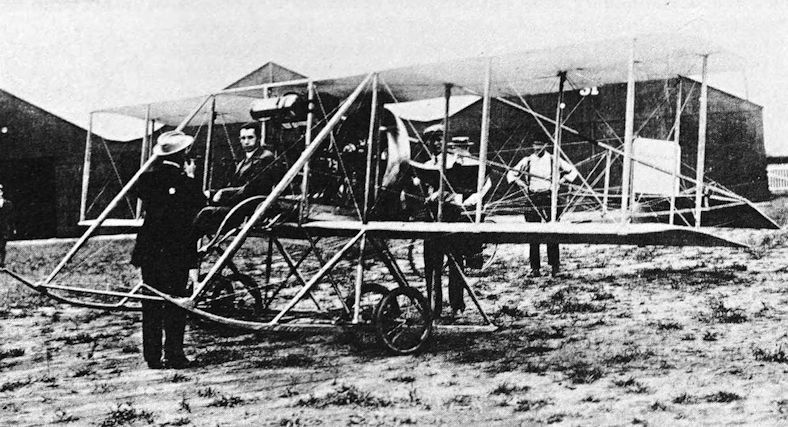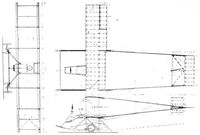K.Molson, H.Taylor Canadian Aircraft since 1909 (Putnam)
McCurdy Biplane
The McCurdy biplane does not properly belong in this book because it was built in the United States. However, it was the only type completely designed by John Alexander Douglas McCurdy, the Canadian pioneer aviator and Canada’s first licensed pilot. It was also the first aircraft designed by a Canadian to be produced in quantity and the first aircraft to make an inter-city flight in Canada.
McCurdy had joined Glenn Curtiss after leaving the Canadian Aerodrome Co in 1910, and at the end of May 1911 he left Curtiss and teamed up with Charles F. Willard to form the McCurdy-Willard Aeroplane Co at 1780 Broadway, New York, to do exhibition flying, but each formed a separate company to make aircraft to their own designs. McCurdy’s company was the McCurdy Aeroplane Co which was formed at Pittsburgh, on 20 June.
McCurdy designed a Gnome-powered headless (Term used to describe an aeroplane without forward elevator) biplane and contracted with the Queen Aeroplane Co of New York City to make six of them. McCurdy made only one brief test hop in the prototype, at Nassau Boulevard Aerodrome on Long Island, probably about 15 July as the machine had to be shipped to Hamilton, Ontario, to fly an exhibition.
McCurdy, Willard and J. V. Martin gave their display from a farm on the outskirts of Hamilton from 27 to 29 July, and the new biplane performed well and gave no trouble. On 1 August an impromptu ‘race’ was held and McCurdy was the winner by flying the 45 miles in 32 minutes, and he landed on a sandbar on Fisherman’s Island, on the east side of Toronto. Willard had left Hamilton 10 minutes ahead of McCurdy, a considerable margin on a 45-mile flight. This was the first inter-city flight in Canada. The following day the two aviators moved to Donlands Farm, northeast of the city, for their exhibition engagement. The field was small and rough, and on his first take off McCurdy’s aircraft was thrown into the air prematurely, crashed and was written off. McCurdy had brought two spare and, apparently, still untried McCurdy biplanes with him and one of these was assembled the next day but not flown.
In August, McCurdy entered the Chicago Air Meet with his biplane, which bore racing number 7 for the event. His winnings were reported as both $2,400 and $1,900 and his best day was on 15 August, when he won the biplane speed contest. During the flying McCurdy collided with some electric wires, his aircraft burnt but he was unhurt.
He was at the Nassau, New York, meeting during 22-30 September with his biplane and then went to Hattiesburg, Miss, but on 3 October refused to fly because of the hot weather. He then moved to Natchez, Miss, and flew there on 19-21 October.
In the meantime, three McCurdy biplanes had been sold. One went to G. G. Hubbard II of Boston who crashed it at Norwich, NY, on 2 September and was injured. Another went to W. E. (Jake) Doherty of Buffalo, who was reported as practising with it at Nassau Boulevard Aerodrome. Another went to a McCurdy pupil, Doctor Weidman, who was also flying at Nassau Boulevard.
In October, McCurdy, Willard and Weidman were reported to be going to Mexico to appear with the Moisant International aviators in mid-November but only Willard appeared. Both McCurdy and Willard rejoined Curtiss in late October.
No further record of the McCurdy biplanes is known; McCurdy may have been restricted to flying Curtiss machines after rejoining the Curtiss company.
One 50hp Gnome Omega. Span 25 ft 8in (7-82 m); length 26 ft 9 in (7-02 m); height 7 ft 3 in (2-21 m); wing area 201-5sqft (18-72sqm). Empty weight 565lb (256kg); loaded weight 825lb (374kg) estimated. Speed 51 mph (82km/h) recorded over a closed course.
Jane's All The World Aircraft 1913
McCURDY-WILLARD. Biplane.
Maximum length, 26? feet (8 m.) maximum breadth, 31-1/3 feet (9.50 m.) supporting surface, --sq. feet (--m?.)
Total weight.--
Body.-- Central skid in combination with 4 wheels. Triangular body, base of triangle on top. Fuselage entirely enclosed.
Planes.-- Maximum span, 31-1/3 feet (9.50 m.) Chord, 3? feet (1 m.) Gap, 5 feet (1.50 m.) Ailerons at trailing edge of wing tips, 6 feet x 2 feet (1.80 X 0.60 m.)
Moto r--
Speed.--
Tractor.-- Diameter, 7? feet (2.40 m.) Pitch, 6 feet (1.82 m.)
Steering.-- Double elevator placed in rear of tail. Control, push and pull wheel. Rudder in rear. Control, wheel. Ailerons. Control, turning steering-wheel left or right.
Remarks.-- See Aeronautics, U.S.A., August, 1911.
* * * * *
There has been also the Baddeck and other early machines (see 1911 edition), but none of them seem to be in existence at the present time.



